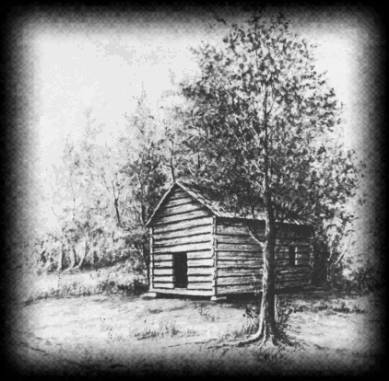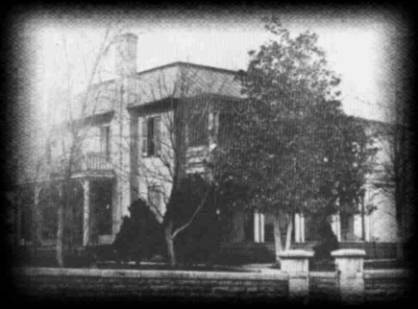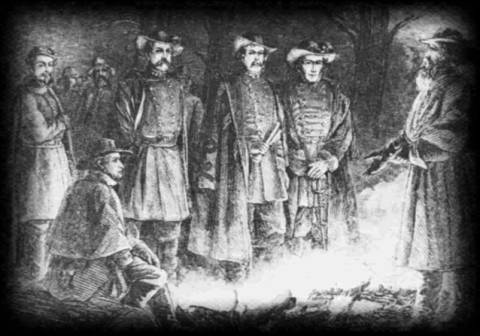
The Battle of Shiloh Begins
![]()

The Old Rugged Logged Church

The Battle of Shiloh Begins
![]()

The Old Rugged Logged Church
After the Unions victories at Fort Henry on February 6th, 1862, and Fort Donelson, along with 12,000 troops taken prisoners from both forts, had broken General Johnston’s Confederate line, in his center, which quickly prompted him to evacuate Bowling Green and Columbus, thus permitting the entire western portion of Kentucky to fall into the hands of the Union. To keep from being completely encircled General Johnston was then forced to abandon Nashville, and to seek a new line on the Memphis and Charleston Railroad.After these combined victories, General Grant was to soon to incur the paper displeasure of General Halleck, because General Grant had sent a division of troops into General Buell’s department in Clarksville. General Grant had left to go to Nashville to consult with General Buell, this infuriated General Halleck, who sent a directive to General Grant to withdraw of this division from Clarksville. General Grant was suspended from his command, and was ordered to return to Fort Henry and await further orders.

Dover Tavern
General Buckner’s headquarters
And
Scene of the surrender of Fort Donelson
With the dismissal of General Grant, General Halleck ordered General Charles F. Smith too command the army and move up the Tennessee and into the heart of the Confederacy. While General Sherman was sent to the Yellow Creek, to destroy all railroad communications, west of Corinth, Mississippi. The waters of the river soon rose to a level, causing Sherman’s mission there to failure. General Sherman then wrote to general Smith, advising him that perhaps a more convenient place for a rendezvous would be at Pittsburg Landing on the west side, of the Tennessee River. Where the roads led to Corinth. General Smith’s reply was for Generals Sherman and Hurlburt to disembark there divisions at Pittsburg landing, and to locate their positions there to afford room for other divisions that was to follow, encamping at or near the river.

Conference of Confederate commanders the night before the battle From left to right, General P G. T Beauregard, General L. Polk (seated), General John C. Breckinridge, General A. S. Johnston, General Braxton Bragg, and Major J. F Gilmer, General W J. Hardee was not present.
General Grant explained to General Halleck his actions at Nashville, and explaining satisfactory his explanation as to why there was poor communication with the general. On March 17th General Halleck issued orders reinstating General Grant to his former command, and included commanding all the troops along the Tennessee river, much to a large part of General Smith’s untimely leg injury, while forming the command.
After arriving at Pittsburg landing, General Sherman encamped his division all along the ridge on both side of the Old Log Church. With the 4th Illinois Cavalry dismounted and just to the left of the church, his line was just 3 miles from Crump’s Landing. General Hurlburt’s division was encamped one mile to the rear of Sherman’s Division. A few days later, General Prentiss’ division took up a position just to the left of Sherman’s command. General John A. McClernand and General W.H.L. Wallace positioned their divisions between Sherman and the river. General Lew Wallace stationed his third division around Crump’s Landing. While all this was taking place is when General Smith received his serious leg wound; it became so serious that he had to give up his command. General Halleck then restored General Grant to his old command. General Grant received his orders to go to Savannah and concentrate troops and supplies; this is why General Grant was not at Pittsburg Landing when the fighting broke out. He had instructions not to bring on a general engagement, at least not until a union was made with General Buell’s army, after this was done General Halleck would then arrive and assume his personal command of the combined force of 47,394.
The Union Forces were not alone busily organizing their armies; General Johnston was orchestrating 43,968 troops all around Corinth. His men were stationed all along the Memphis and Charleston Railroad. General Johnston, hearing that General Buell’s army was nearing Savannah, decided he had better attack Grant at once before their arrival; so on the 3rd of April he issued orders for a forward movement of his army towards Shiloh, all the while hoping to engage the federal force before the two armies merged at Shiloh. General Johnston planned to attack on April 5th. But because of a heavy down pour of rain, the roads became muddy making for very slow travel. General Johnston postponed the attack until daylight of the following morning. The confederates were now camped and formed in three lines, all within and sometimes closer than two miles of the federal camps. General W. J. Hardee’s corps and one brigade of General Braxton Bragg’s brigades made up the first line, while the remainder of General Bragg’s Corps in the second line, the third line was made up of Generals Leonidas Polk and J. C. Breckinridge’s corps.
April 5th 1862, around three o’clock in the afternoon, the pickets that was sent out by General Sherman, had left their post, the pickets were being lead by a young lieutenant who advanced forward and was captured by the confederates. General Sherman sent Major Ricker, of the 5th Ohio Cavalry to proceed quickly to where the picket was station. Major Ricker ascertained the circumstances, and then ordered his regiment forward approximately two miles, there they found a brigade of union infantry that had already been sent out, and was engaged with a confederate cavalry unit. Ricker’s 5th Ohio Cavalry, combined with the union infantry drove the confederate cavalry to a place call the Ridge Road. Where there a unit of Confederate Artillery fired on them. Ricker’s Cavalry then returned to General Sherman and reported the incident. General Sherman wrote to Captain J.A. Rawlins, the Assistant Adjutant-General, District of Western Tennessee. “I infer that the enemy is in some considerable force at Pea Ridge, in formed Head Quarter of the incident of the above and that one First-Lieutenant and seven men from the Ohio 7th Infantry were captured along with one Major, one Lieutenant 5, privates of the 72nd Ohio, and 8 soldiers were wounded.
So now the stage was set, for one of our Nation’s bloodies battles to be fought, both armies encamped within just a very short distance of each other; they could hear each other, for history to write that the Union Forces were surprised I believe this to be wrong, I would rather that judgment be left up to you the reader. General Sherman now gave orders for preparations of a defense of his lines.
(Note: Sherman in his memoirs wrote he did not give the order to set up defensive positions,) “I always acted on the supposition that we were an invading army; that our purpose was to move forward in force, make a lodgment on the Memphis and Charleston road, and thus repeat the grand tactics of Fort Donelson, by separating the rebels in the interior from those at Memphis and on the Mississippi River. We did not fortify our camps against an attack, because we had no orders to do so, and because such a course would have made our raw men timid. The position was naturally strong, with Snake Creek on our right, a deep, bold stream, with a confluent Owl Creek to our right front; and Lick Creed, with a similar confluent, on our left, thus narrowing the space over which we could be attacked to about a mile and a half or two miles”. (Sherman wrote later during the war, that at a later period of the war, we could have rendered this position impregnable in one night, but at this time we did not do it, and it may be it is well we did not.
It was just a few hours before the battle of “Shiloh”, that General Sherman wrote a message to General Grant who was in Savanna: "I have no doubt that nothing will occur today more than some picket firing," and that he did not "apprehend anything like an attack" on his position. The same day, after Sherman's report from the front, Grant, who was at Savannah, telegraphed Halleck: "I have scarcely the faintest idea of an attack being made upon us, but will be prepared should such a thing take place."
April 6th, The union camps were busy rising for a new day, some men were cooking their breakfast, while others were waking from their evenings rest, this peaceful silence soon was broken by the sound of musketry fire, General Prentiss’ pickets encountered Hardee's Confederate skirmish line and was driven back to Major Aaron B. Hardcastle’s lines, which was a short distance in front of General Sherman’s five camps. Four companies of the 16th Wisconsin and five companies of the 21st Missouri were reinforcing the three companies of pickets, who were now fighting there way back and retreating quickly towards these lines, the three companies being from the 25th Missouri infantry. Sherman’s troops were, in turn, reinforced at the northeast corner of Rhea Field by Colonel Everett Peabody’s brigade. Here they were able to hold off the Confederate attack until around 8 a. m., then the order was given to fall back, so they a reconnoiter to General Prentiss' line of camps, being followed closely by the confederates.
Hearing the musketry fire General Sherman immediately issued orders for his division to be put under arms, and posted an artillery battery at the old logged church with another on the ridge just to the south. As the battle began to heat up it was the left of line, which was to receive the full impact of the Confederate charge. At the same moment General Prentiss was being attacked. One of the regiments to the left of the brigade was the 53d Ohio, consisting of raw recruits who had never before experienced the horrors of war. This unit was unable to withstand the fierce attack of the Confederates; it didn’t take them long to break their lines and flee to the rear. The commander of the 53rd Ohio was a Colonel Jesse Hildebrand he refused to leave the field. Since he no longer had any troops of his own, acted as an aide to General McClernand for the remainder of the day.
Ronald R Wallace
Part II General Prentiss' Camp
Return to The Home Page of 4th Illinois Cavalry